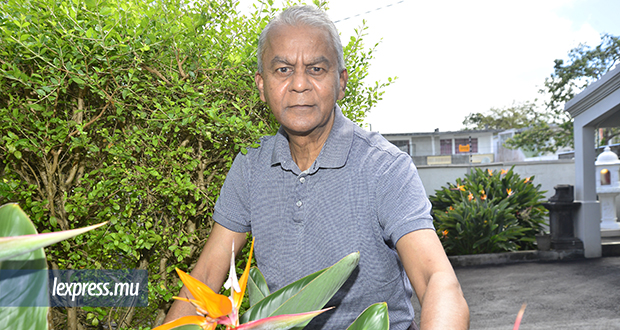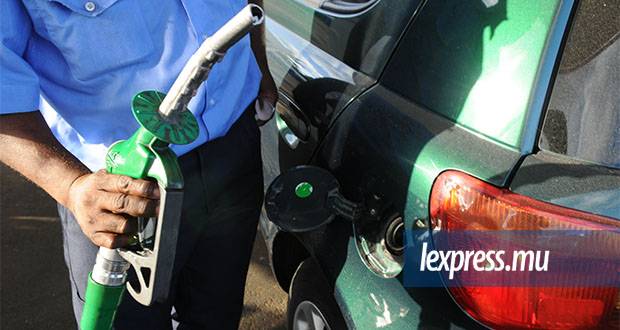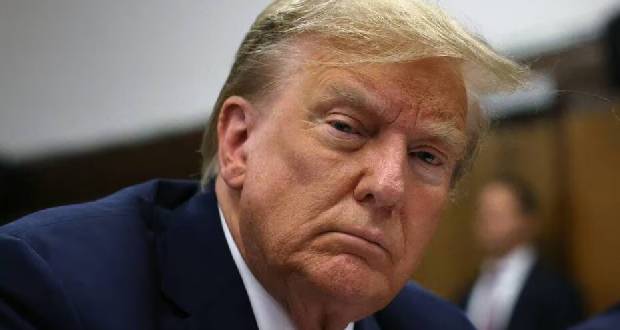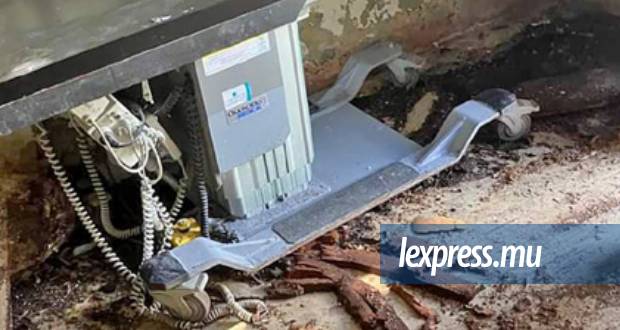Publicité
Ramesh Basant Roi: «Why do some people still have preference for cash in our economy…»
Par
Partager cet article
Ramesh Basant Roi: «Why do some people still have preference for cash in our economy…»

It boggles the mind of Ramesh Basant Roi : «Why does a class of people in Mauritius have a preference for cash, particularly for high denomination banknotes ?» The former Governor of the Central Bank explains why the entire family of banknotes in the country must be replaced. A real lecture for our parliamentarians who blindly followed the Prime minister and minister of Finance in resisting the monetary change.
A rising number of counterfeited Rs2,000 banknotes is reported to be in circulation. Sellers are being advised to check their genuineness with the help of an electronic equipment. Is there any alternative way of ascertaining the genuineness of banknotes?
An analogue policy and decision maker in a digital age is a harmful misfit. Let me reply in stages. Not long ago, security features on banknotes were embedded in a manner that were known only to the issuing authorities. As counterfeiting gathered momentum, the look, character and refinements of security features evolved spectacularly. They have been made viewable with the assistance of UV counterfeit detectors in the last few decades. Seen against a backdrop of a troublesome surge in counterfeiting, greatly facilitated by people’s easy access to advanced digital technology, daily users of banknotes cannot be reasonably expected to have a UV counterfeit detector with them all the time. Developers of banknote security features have responded with technological breakthroughs to the urgency of protecting the public from counterfeiting.
Since more than 10 years, highly sophisticated banknote security features that are extremely difficult and very costly to reproduce faithfully, more so if multiple security features are embedded in the banknotes, are available to all issuing authorities. In the central banking community, it is very well-known that several banknote printing companies source their banknote security features from a reputed Swiss company that has acquired advanced expertise in their design and production. The sophisticated security features make the authenticity of banknotes readily verifiable without the assistance of cumbersome counterfeiting detectors. Our future banknotes could have distinctive top to bottom transparent windows with multiple images that can hardly be faked. Simply tilt such a banknote with sophisticated security and tactile features, you would see, for instance, a shiny flying bird or any object inserted therein that is impossible to reproduce at low cost. In their optical character, the seemingly mica-like materials exhibit colour variations. Anyone holding the banknote is capable of visually verifying its authenticity by simply tilting it in any direction. By now, Mauritius would have had banknotes that obviated the need for UV counterfeit detectors if the issuing authority was not barred from proceeding with the replacement of the current family of banknotes.
It appears that the Rs2,000 banknote is the most counterfeited. Does this denomination need to be dropped from the current and future family of banknotes?
It does not go to say that counterfeiting will stop if the Rs2,000 banknote is eliminated from our family of banknotes. The Rs1,000 banknote would quite likely emerge as the next preferred candidate for counterfeiting. Bear in mind the simple truism: what is man-made can always be reproduced by man. The best that any serious banknote issuing authority can do to protect the public from counterfeiting is to make the design of the banknotes and the security features therein as costly and un-reproducible as possible. Once the bonanza from counterfeiting is made a costly and near-impossible endeavour, the risk of counterfeiting is reduced to a bare minimum.
An objective analysis of the composition, structure and usefulness of certain denominations of our coins and banknotes currently in circulation would lead you to a few constructive conclusions. I have done it and I cling tenaciously to the conviction that the Rs2,000 banknote must be done away with once for all.
How would you justify the elimination?
Very large denominations of banknotes used to exist in Mauritius about a decade before Independence; they were convenient for and used exclusively for inter-bank payments and settlements. They were done away with as the banking industry came up with innovative ways and means of payments and settlements among themselves.
Mauritius had introduced the Rs2,000 banknote at a time when internet banking - that allows for small and large value payments and settlements between private individuals, companies and between banks - did not exist. That the Rs2,000 banknote was convenient for handling of cash in bulk was the only motivating consideration for its introduction. If that was the only justification for having this banknote, given the ubiquity of internet facilities across the country, electronic transfers and payments for transactions are indeed superconvenient. They simply require an effortless click of the mouse. Hundreds of millions of rupees are electronically transferred from one party to the other; they are funds backing legal transactions taking place in the country every day. As much as Rs3 trillions of transactions, equivalent to six times the GDP of Mauritius, are settled electronically each year.
«The portraits on our banknotes are allocated strictly along communal lines, a reflection of the spirit of our best-loser system.»
Farmers in Africa, Asia, and in the Indian sub-continent who have barely been to school are skillful at using electronic payment systems. Why do a class of people in Mauritius with reasonably good educational background has a preference for cash in our economy? Why do they still have preference for cash, particularly high denomination banknotes, if cash payments above a limited amount is restricted by law? Aren’t they meant to thread a different needle? I am inclined to believe that it’s not at all a question of people being aversive to our electronic payment systems. It’s premeditated avoidance.
To those who have been shouting about Fintech in the past few years and support a cashless society so loudly, my question is: why an issuing authority that supposedly seeks to promote digital technology in our financial sector aimed at serving consumers of banking services efficiently is, at the same time, in favour of high denomination banknotes that rather promotes usage of cash in our society? It’s cognitive dissonance stretched to its superlative.
Besides, the Rs2,000 banknote is the most expensive banknote in our family of banknotes – an avoidable burden on the balance sheet of the issuing authority. Seen in these lights, the Rs2,000 banknote serves no useful purpose. Its raison d’être has expired; it can be discarded without causing any disruption in our payments and settlement system. Several central banks, including the European Central bank, have withdrawn their highest denomination banknotes because they are found to be more convenient for laundering purposes.
Earlier you said the entire structure of the family of coins and banknotes must be rationalized. What do you mean by rationalization?
With regard to our coins, it makes perfect sense to eliminate the one cent coin. It no longer serves any useful purpose and the issuing authority does no longer get them minted. This is not a novel idea. A few advanced countries have done away with it. For operational purposes, the one cent coins exist only digitally; physically it does not in these countries. It appears to be a simple undertaking but it’s deletion is quite complex in real life if it’s done without any hitch that would hamper our payments and settlement system. I initiated the process way back in 2015 but I admit having been unable to go ahead with the undertaking for lack of support.
There is an incongruity in the existing composition and structure of coins in circulation. My predecessor introduced the Rs20 coin. It was a move in the right direction. It does not, however, make sense to have a Rs20 coin in circulation side by side with a Rs25 banknote. It’s superfluous in the entire set of currency in circulation. I guess, he may have been perceived as having sailed beyond the horizon in this enterprise.
Without being metaphorical, what’s your guess?
If you want me to be blunt, I’ll be blunt. The portraits on our banknotes are allocated strictly along communal lines, a reflection of the spirit of our best-loser system. Anyone who was born twenty years ago – and even a few years more - must have been seeing the fine distribution of local personalities on a communal basis on our banknotes throughout his life so far. Growing into adulthood with these banknotes does not help free the younger generations of breeding ethnic biases over time. I have been asked this embarrassing question many a time by the millennials. To believe that we have done our best to foster a spirit of nationhood is to believe astrologists rather than physicists in astronomy. It’s selfdeceit. There may have been a touch of sense in having the personalities on our banknotes but many rightminded and apolitical individuals of all the strata of our society do believe that they have overstayed their welcome.
On the Rs25 banknote, we have the portrait of a sino- Mauritian. I guess the issuing authority had found itself in an extremely impossible position to eliminate a sino-Mauritian from the family of banknotes. Ethnic considerations may have suffocated the attempt to rationalize the structure and composition of the family of banknotes. That’s one of the reasons I had bandied the idea of replacing all the political personalities on our banknotes by images that are typically Mauritian and of historical significance. We are definitely not short of them. I did make a serious attempt, but I was dismayed to discover that it’s indeed very hard to improve a home in a deteriorating neighbourhood.
You seem to still stick to the view that the entire family of banknotes in the country must be replaced. Would you mind enlighten our readers on your justification?
Indeed, yes. In the first half of the 1990s, the G8 had an understanding that the rising tides of the drug business and money laundering coupled with the easy access of people to sophisticated techniques of reproducing documents world-wide, banknotes and the security features must be updated every 7 to 8 years. We have a family of banknotes that has not been replaced for nearly 20 years. In fact, a few inconsequential changes have been made to the security features and we moved from paper to polymer. Essentially, the character of the banknotes has remained those of the ‘‘garden variety’’. There is no single and valid argument that goes against a new generation of our banknotes. I don’t see any.
I had made the following disturbing observations in 2015: banknotes and coins in circulation had been growing and continues to grow by more than 10 per cent per annum despite the sluggishness of the economy. Why? It seems there has been a remarkable shift in our economy from making and selling goods to manipulation of money. The money culture was booming - an outward sign of an inner sin. With the growing popularity of credit cards, debit cards, phone banking, internet banking that allows for transfer of funds from one party to the other and other electronic facilities for large value payments and settlements, anybody would have expected the growth rate of currency in circulation to decline as is evidenced in other parts of the world. Why should the growth of currency in circulation in Mauritius continue to remain so high yearin and year-out? It’s very telling. I need not elaborate.
If we decide not to be false to ourselves and false to everybody else and we do want safe and quality banknotes that speak well of our jurisdiction, I would suggest that the current family of banknotes and coins is completely recast and rationalised, not only as a retaliation against the surge of counterfeiting and money laundering but also because of incongruities in the structure of our currency in circulation. It’s messy and it speaks poorly of the issuing authority of a country that is at the centre of a developing financial centre.
Why this emphasis on rationalisation?
The rationalisation must be an integral part of the bigger game plan I had in order to speed up the process of making Mauritius a cashless society. The National Payment Switch, a project intended to make electronic payment system more accessible at a lower cost to more consumers, fits perfectly in the overall game plan. By the way, it ought to have been operational in May last. I trust its implementation has not been abandoned. We have to fast forward our travel to a cashless society.
I recall a figure of Rs600 million was mentioned in the National assembly. Does it cost that much to replace a family of banknotes?
I was on mission overseas at the time. I was myself flabbergasted after I was made aware of the phantasmagorial figure. The figure was a construction; it was calculated on the basis of surreal artefacts. Guys, when you find turkeys in your immediate surroundings at your workplace, never try to soar like an eagle. You will discover birds of ill omen hovering over your head.
The project was still in its very nascent stage. I had wished to propose to my Board of Directors the deletion of the Rs2,000 banknote - the most expensive one serving no useful purpose. In the new configuration, the Rs25 banknote would also have been dropped because of the Rs20 coin. It was also in the plan to replace the current polymer banknotes with banknotes printed on a materially improved version of the polymer having far longer life spans. The annual replacement cost of soiled notes would have drastically diminished. These would have, of course, substantially brought down the overall cost of the banknotes. My best estimate was a figure much less than Rs300 million if there was a decision to replace the entire family in a single shot with the proposed version as outlined. One has to be a certified idiot to believe that any step forward to move to a cashless society is not a step forward to bring down the cost of minting coins and printing banknotes.
Does anyone out there realize by how much taxes evaded due to underground activities of over Rs 35 billion would be enhanced with further progress towards a cashless society ? Cost reduction is possible because issuing authorities have driven change in the banknote printing business. The client imposes on the banknote printer firms that have specialized in producing key components that go in the making of a banknote. In other words, several firms are involved as opposed to the traditional way of allocating the tender to a single firm. The business model has changed and cost has gone down accordingly. The client has to be aware of it instead of being noseled by the banknote printing firm.
I had a proposal to stagger the replacement of the family of banknotes over years because of the fast evolving digital technology. It’s a very bad strategy to replace a family of banknotes in a single shot as it has been done since the beginning of the 1970s. The issuing authority needs to bear in mind that it’s getting banknotes printed, not wedding cards. As such anticounterfeiting designs and quality of the polymer prevail over all other considerations. The rationale for staggering is very simple: as the years go by, the security features in each denomination is able to catch up, on a rolling basis, with the innovation taking place in their production. For security reasons, an entire family of banknotes should not lag behind innovation.
You made subtle references to hoarding of money derived out of financial crimes. Do I understand that these are the only considerations for a replacement of the family of banknotes?
No. I also had macroeconomic stability considerations in mind. Those who are familiar with the currency crisis due to capital flight like the one in 1997-98 and the less intense one in the aftermath of the taxation of interest income, will recall how hard I did try to stem capital flight. Let me explain:
We have a huge current account deficit year-in and year-out for about a decade. The deficit is being financed by capital inflows. Part of the inflows are what we refer to as official flows and part of it is private flows. The bulk of the private inflows is, in my view, of questionable character. We are told those flows relate to foreign direct investment. If foreign direct investment is so big year-in and year-out, why is it not reflected in higher growth performance of the economy? Attempts have been made to breakdown the flows and to understand their roles in the economy. But the statistics turn out to be a “riddle wrapped in an enigma inside a mystery.” The risk of a sustained huge deficit in the current account and of an external debt accumulation giving rise to balance of payments crisis at some stage is clear and present. It would be foolhardy to take the risk dismissively. (...)
According to the MRA, the size of the underground economy is estimated at Rs35 billion. Do you also believe that the size is that big?
I told you about the more than 10 per cent annual growth rate of currency in circulation. The underground economy and, importantly, money laundering activities keep swallowing high denomination banknotes in the country. I would tend to believe that the size of the underground economy is quite larger than Rs35 billion.
What would be the amount of money laundered annually in our jurisdiction?
Ours is not a money laundering jurisdiction. Attempts have been made by rival jurisdiction to label us as such. True, we do have cases of money laundering by high profile launderers as anywhere else in the world.
The drug business has prospered in Mauritius. Wherever the drug business prospers, money laundering activities balloons. We have had a few cases of so to say foreign investors taking advantage of weaknesses in the implementation of our antimoney laundering laws and guidelines. Studies based on market intelligence show that individuals seeking to launder their ill-gotten money usually forego an average of 30 per cent paid as “speed money” in the whitewashing process. When that kind of money is thrown around by launderers in any jurisdiction statistics for working out a credible estimate of the overall size of money laundered cannot be trusted. Even a guesstimate becomes hazardous.
Do you believe that a repeat of what Prime Minister Modi did in India would in any way resolve some of the problems associated with the underground economy and money laundering in Mauritius?
Prime Minister Modi had a bold commitment and a well-guarded “shock and awe” strategy. He made a surprise attack, brought hundreds of thousands of tax-evaders in the tax net and raked substantial government revenue.
I would say it’s too late for Mauritius to go for a “shock and awe” strategy. If you do so, you would be shutting the barn door after the horse has bolted out. Having known how people holding huge cash balances react to bad news in Mauritius, I am sure that a process of de-stocking of Rs2,000 banknote has already started following the recommendations made in the latest Commission of Inquiry on Drugs. The current family of banknotes was introduced way back in 1999. We had set a deadline for the exchange of old banknotes for the new. I do recall some interesting anecdotes that were very revealing of a specific class of professionals in the country.
In the public interest, it would be useful to know how much, if any, of the pre-1999 family of banknotes have not yet been returned to the issuing authority. If, after nearly 20 years, you would happen to find people still stuck with a massive amount of the pre-1999 family of banknotes, I would gladly ask you to lean back in your sofa and take a hard and objective look at your society.
Most of us are generally well informed in the country. We have the facts – facts that are fairly reliable. The trouble is not with the facts. The trouble is that we force-feed biases and are unwilling to draw honest conclusions. Even when we happen to draw honest conclusions, self-deceit often prevails over them. And we sink into a universe of surrealism.
Publicité
Les plus récents






